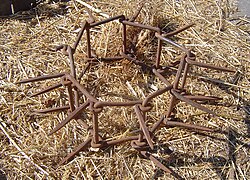You can help expand this article with text translated from the corresponding article in Catalan. (October 2023)Click [show] for important translation instructions.
|
This article needs additional citations for verification .(October 2023) |



A wolf collar (also known as Italian : roccale or vreccale, Spanish : carlanca) is a type of dog collar designed to protect livestock guardian dogs from attacks by wolves. Wolf collars are fitted with elongated spikes to stop wolves from attacking dogs on the neck. Such collars are used by shepherds in many countries including Italy,[ citation needed ] Spain [1] and Turkey.
Contents
Ancient Greeks used such collars to protect their dogs from wolf attacks. [2]
In Latin the collar was called mellum or maelium or mellum or millus. [3] [4] Marcus Terentius Varro wrote that the farm dogs should have spiked collars for protection against wolves and other wild animals. [5] Varro wrote that the collar was a strong leather belt around the neck, equipped with nails. Beneath the nails, a soft leather padding is sewn in to prevent the iron from harming the dog's neck. [6]
War dogs in ancient Greece and Rome had collars with large spikes. [7] [8]